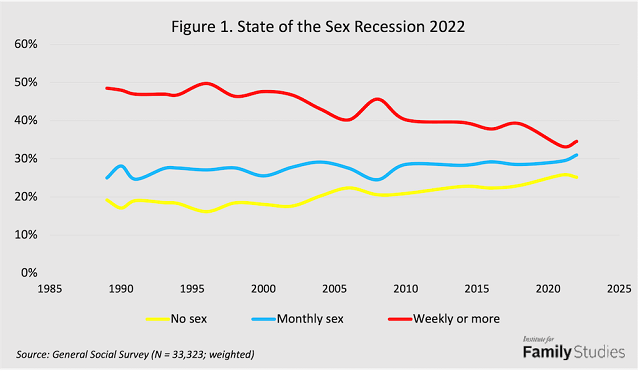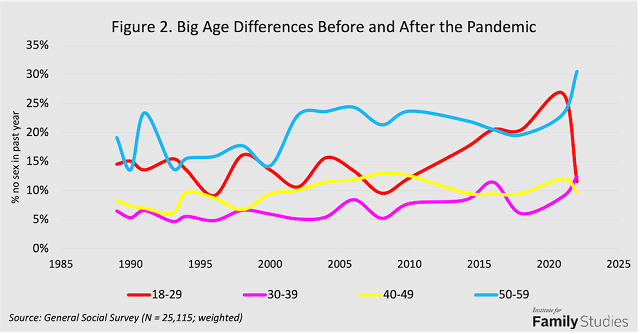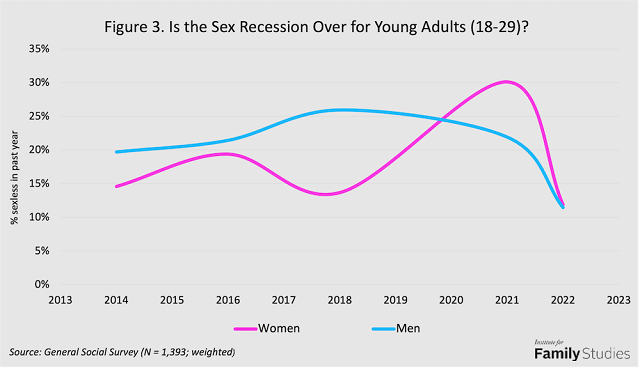Highlights
- It’s surprising that America’s sexual behavior hasn’t changed more in the past couple of years. Post This
- Something big changed after 2020. Celibacy skyrocketed for Americans in their 50s, while plummeting for adults aged 18-29. Post This
- The big story of the sex recession has always been the age differences. Post This
For me, the release of the 2022 data from the General Social Survey (GSS) could only mean one thing: what’s going on with the sex recession? Back in 2021, I examined the previous decade of data from both the GSS and the National Survey of Family Growth. I tried to get a handle on whether the sex recession had worsened over the previous 10 years. The answer was equivocal: there wasn’t strong evidence of a decadal trend in celibacy, although celibacy had definitely spiked in 2017-2019.
2020 was a rough year for the United States, rivaling 1968 in the annals of anni horribiles. Consequently, any new directions in American sexual behavior may not be trends but one-time reactions to all the upheavals of the past few years. With this in mind, it’s surprising that American’s sexual behavior hasn’t changed more in the past couple of years (Figure 1).1 The downward trend in the number of Americans reporting sex at least once a week steadily continued, sinking to 33% in 2021 before rebounding slightly to 35% in 2022. This represents a notable decline since 1989, when almost half the country reported weekly whoopee (the GSS only started collecting these sex data, surprisingly reliable, that year). Meanwhile, rates of monthly sex chugged along at a stable 30%, while celibacy held steady at about 25 percent.

The big story of the sex recession has always been the age differences. These are shown in Figure 2 for Americans up to age 59. The sweet spot for avoiding celibacy is in your 30s and 40s. Rates for this group have fluctuated some over the years but for the most part have held steady at about 10 percent. By this point, most people have partnered up—or partnered up more than once—but aren’t old enough to forsake partnering up. They also aren’t old enough to confront infirmities that might reduce the odds of regular sex.
Meanwhile, rates of celibacy are much higher for people aged 18-29 and 50-59. The younger cohort may be focusing on school and careers, or are just slow starters in the game of love. But something big changed after 2020 and the pandemic. Celibacy skyrocketed for Americans in their 50s, while plummeting for adults aged 18-29.
Of course, we can’t know for sure what’s going on with these data, although one possibility can be ruled out. The COVID mortality rate was tragically high for older Americans, but too low to explain their rise in celibacy. My best guess is that some people got out of the habit of dating after the plague hit, and never got back into it.

Younger people, of course, aren’t so prone to forming permanent habits. Figure 3 breaks down rates of sexlessness over the past 10 years by gender for adults aged 18-29. There have been big changes since 2020, with levels of sexual activity in 2022 reaching highs not seen for 25 years. Last year, just 12% of women and 11% of men reported not getting busy in the past year. Young men got there much more quickly; in 2021, young women reported the highest level of celibacy observed since 1989.
What explains that spike in celibacy, and why only women? My best guess reflects a fundamental difference between the sexes: men are bigger risk-takers than women. Faced with a deadly pandemic, young women stayed home in 2020 and 2021 at a much higher rate than did their male peers.

We shouldn’t declare the sex recession over based on just a single year of data—especially a single year that relied on new survey methods—and a fairly small sub-sample of 229 respondents. But the numbers are definitely moving in the right direction. Perhaps the pandemic led young people to reconsider what’s really important in life?
Nicholas H. Wolfinger is Professor of Family and Consumer Studies and Adjunct Professor of Sociology at the University of Utah. He is the author of Thanks for Nothing: The Economics of Single Motherhood since 1980, coauthored with Matthew McKeever, forthcoming from Oxford University Press.
1. The 2012 data are incompatible and anomalous, so they are omitted. Celibacy data for this year can be imputed from another variable, PARTNERS rather than SEXFREQ, and they yield results consistent with the trends depicted here.










